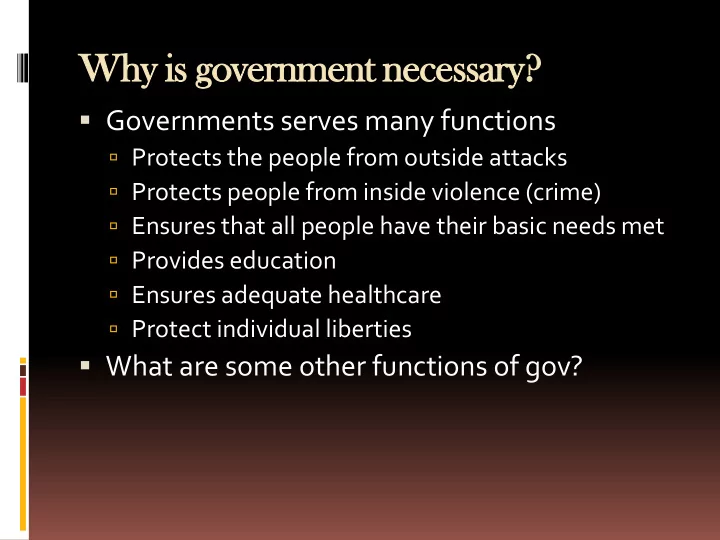

Why is government necessary? Governments serves many functions Protects the people from outside attacks Protects people from inside violence (crime) Ensures that all people have their basic needs met Provides education Ensures adequate healthcare Protect individual liberties What are some other functions of gov?
Government Basics: Government: the institution through which society makes and enforces its public policies Public Policy: all the decisions that a government makes for its people Government must have POWER to make & carry out its public policies Types of Powers: Legislative Power: the power to make law/policy Executive Power: the power to carry out & enforce law/policy Judicial Power: the power to define & interpret the law and the power to settle disputes Constitution: a country’s basic beliefs about government including its principles, structure, framework, and processes – usually written. Politics: the process thru which government is conducted
The State: The State is the dominate political unit A State must have the following: Population: the people living in a state. Homogeneous: all people share a common culture, language, ideology, etc Heterogeneous: people come from different cultures, languages, etc. Defined Territory: the land a state occupies w/set & recognized boundaries Organized Government: a way of making & enforce laws Sovereignty: supreme and absolute power w/in own boundaries – no other state can claim power over it
Types of Governments: Republics Autocracies Republic: a government (Totalitarian Regimes) ruled by the people Dictatorships: a type of Democracy: a government government controlled by in which the supreme 1 person w/absolute authority rests with the people control Direct democracy: all citizens Oligarchy: a type of rule government controlled by Indirect/Representative small group Democracy: citizens rule thru elected representatives Monarchy: a type of government controlled by a king/queen
Types of Governments Autocracy Democracy Governments Governments ruled by ruled by the absolute leader people (s ) Indirect Democracy Oligarchy Direct Democracy (Representative Dictatorship (Pure Democracy) The power to rule Democracy) The power to rule The people make all is held by a small The people elect is held by 1 decisions of the representatives to group of government via person make government individuals meetings & voting. decisions Absolute Constitutional Military Republic Monarchy Monarchy The people who are Dictatorship The nation has a The right to rule eligible to vote choose The ruler is put in king/queen, but is led the representatives to is handed down by an elected group of power by the make government from generation people. Example, decisions military Great Britain to generation
Evolutionary Theory: Development of Government Developed naturally from the family structure One family member gained more respect/power & became the designated leader Force Theory: Developed as one person or group took control through military strength Divine Right Theory: The belief that the right to rule came from their God Social Contract Theory: The belief that government is a “contract” between the people & the leaders Leaders provide order & protection People give up certain rights Developed by Thomas Hobbes & John Locke
Distribution of Power Unitary System of Government Most power held by a strong central government State/local government serve only to carry out the duties of the central government Examples: Great Britain (England) & France Federal System of Government Power is held equally between a central government and state/local governments Division of Powers – each level has specific powers that they can exercise independently Examples: United States & Germany Confederation An alliance between independent states to work together Extremely strong state governments Central authority holds little true power, usually only authority of trade and defense Examples: the European Union & United Nations
Systems of Power Distribution Unitary Federal State & Local gov Central State & gov Local gov Central gov Central gov State & Local gov Confederation
Presidential v. Parliamentary Systems Presidential System Parliamentary System Executive & legislative The executive (Prime branches are independent Minister) is the leader of of each other the legislative branch President is chosen by the The PM is under the people parliament’s authority Each branch has separate Can be removed from authority office via a “no confidence” vote by parliament Legislative & executive can Example: Great Britain check the other’s authority Example: USA
Five Basic Beliefs of American Democracy 1. Recognition of the fundamental worth of the individual 2. Respect for the equality of all persons 3. Faith in majority rule w/respect to minority rights 4. Understanding of the necessity to compromise 5. Insistence on individual freedoms
The Basic Beliefs Explained… Worth of the Individual: Each individual is a separate & distinct being Sometimes the rights of the individual must give way to the whole Equality for all persons: American gov. guarantees two types of equality Equality of opportunity: no person can be held back on basis of gender, race, religion, etc. Equality under the law: law applies equally to all persons Recognizes that all men are not created “equally,” but they should still be treated “equally”
The Basic Beliefs Continued Majority Rule/Minority Rights: Will of majority is what decides public policy thru elections Assumes that the majority will is right more that it is wrong To protect the “minority” will, laws are in place to protect the minorities from discrimination Necessity of Compromise: Compromise is the blending or adjusting of beliefs to meet the needs of the most people Individual Freedom: People must be as free as possible A person’s rights extend only as far as they do not interfere in another’s rights “…my right to throw a punch ends where another’s nose begins…”
Purposes of American Government Located in the PREAMBLE to the Constitution Preamble lists the goals & objectives of the US government We the People of the United States, 1. in order to form a more perfect union 2. Establish Justice 3. Insure Domestic Tranquility 4. Provide for the Common Defense 5. Promote the General Welfare 6. And to Secure the Blessings of Liberty to ourselves and our posterity Do ordain and establish this Constitution for the United States of America
Recommend
More recommend